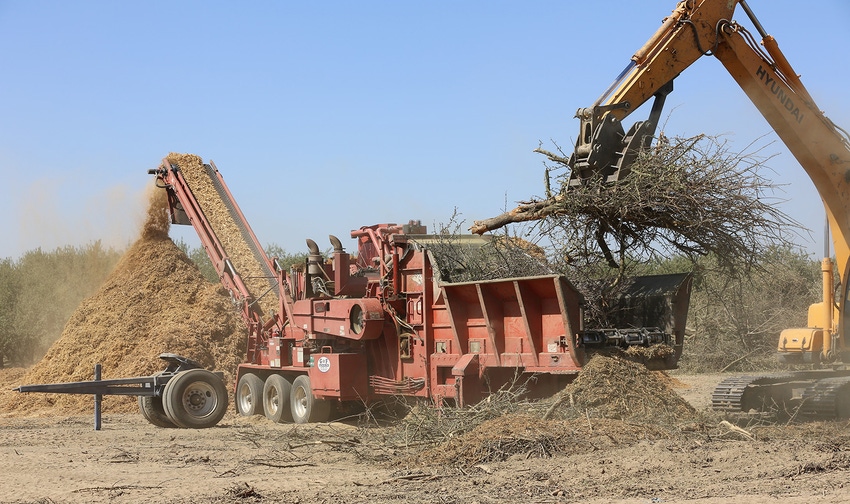
Unpredictable climate conditions and higher prices for almonds have spurred growers to turn their orchards over faster, ripping out older, less-productive trees and planting newer, faster-growing, less-water-intensive varieties.
In theory, a reasonable and prudent action and one the Almond Board of California estimates will involve some 40,000 trees over the next decade, trees that have outlived their productivity among the state’s 7,600 almond growers and processors.
That leaves a lot of dead wood that used to be burned in the field or sent to biomass power generation plants. But since 2015, burn permits are few and far between and biomass generation plants have dwindled in number.
Being touted now is the concept of whole-orchard recycling, the on-site grinding/chipping of whole trees and the incorporation of that chipped biomass into the topsoil prior to replanting.
WOR is lauded as a sustainable method of tree removal that enhances both air and soil quality and reduces the emission of greenhouse gases that contribute to climate change.
University of California, Davis research reports that WOR increases the health and productivity of the subsequent replanted orchard and its soil base while at the same time sequesters carbon, improves soil structure, and increases water use efficiency.
Published study results indicated an increase in water-use efficiency and crop yield, both about 20%. Report author Amelie Gaudin, an agroecology professor of plant sciences, was impressed with the water part of the equation.
“Water is central to how we think about agriculture in California and this is a clear example of real benefits for water conservation.
“WOR practices build soil potential to become a carbon sink while building nutrients and improving water retention — all important factors as water becomes more limited.”
‘It’s a new day’
Brent Holtz is one of the six study co-authors. The farm advisor for UC Cooperative Extension in San Joaquin County says, “It’s a new day. Clean Air Act restrictions mean growers can’t burn in the field anymore and cogeneration plants have closed. In the old days, no organic matter was going back into the ground.
“On the plus side, over seven years of monitoring whole orchard recycling, we’ve found the wood chips we’re now putting back in the ground are building carbon and soil organic matter and increasing water-holding capacity. This is a win-win-win from our viewpoint because our soils in the San Joaquin and Sacramento Valleys are pretty low in organic matter.”
There are other things to consider however. “When you’re removing an orchard and the wood chips are about 50% carbon, you’re adding about 54,000 pounds of carbon per acre, so you’ve altered the soil chemistry, that carbon-to-nitrogen ratio, quite a bit and we’re working on modifying that ratio so trees won’t be stunted by all that carbon,” Holtz says.
Numerous trials have shown that early nitrogen applications — no more than one ounce per tree in the first year of growth — spurs shoot growth.
Some concern has been expressed about disease in old trees that could be spread via the wood chips.
“We haven’t seen a problem with that,” he says, alluding to another difficulty. “Some growers are worried they’re going to be picking up recycled wood chips left over from the previous trees, but we found that a plow and rototiller took care of that concern better than a disk.”
Grower reaction to a process that will improve soil health has generally been favorable. Grower numbers and WOR acreage is growing.
“This whole arc of recycling is being accepted,” Holtz advises.
Another positive is that the concept falls under the umbrella of healthy soils program efforts and some funding is available for recycling.
“The likelihood is that growers will do well by adopting whole orchard recycling, will see an increase in yield, and can go back and get paid for their conservation efforts,” he says. “If I give growers advice, I suggest this is a new and different way to do things…and it’s a better way that should be considered.”
For more news on tree nuts as reported by growers and farm advisors, subscribe to the Tree Nut Farm Press e-newsletter.
Read more about:
AlmondsAbout the Author(s)
You May Also Like




